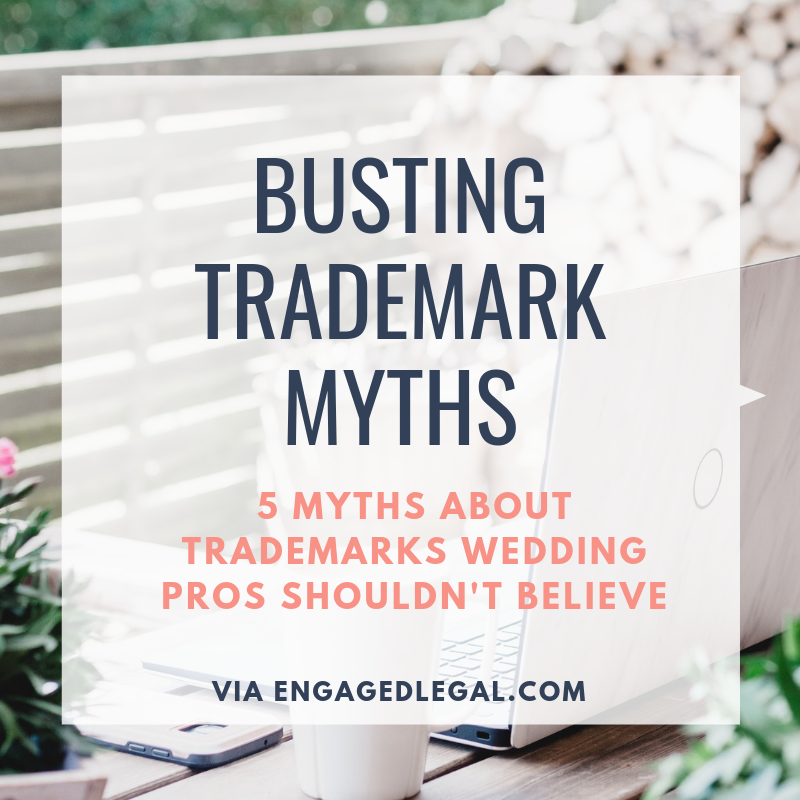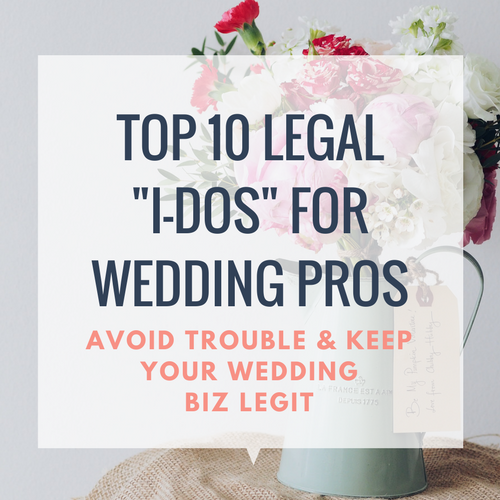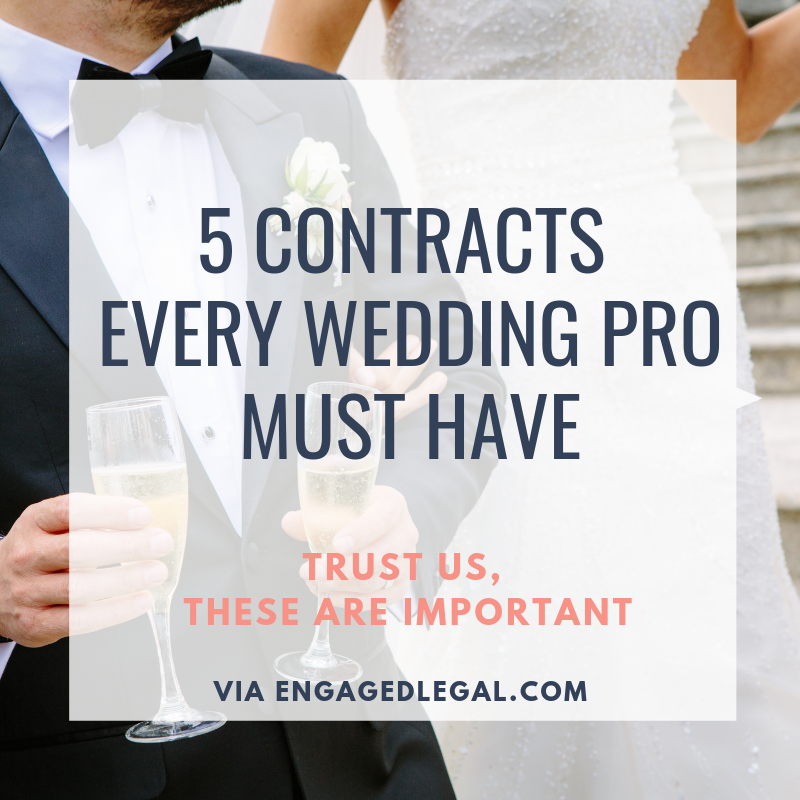5 Myths about Trademarks Creatives NEED to Stop Believing
/NOTE: If you’re a “trademark beginner,” try starting with Simplified: Trademarks for Wedding Pros for the nuts-and-bolts and then come back to read this!
In my “day job,” (hint: not this blog) I have worked with trademarks for years. I’ve taught classes to other attorneys on filing and enforcing trademarks. And I feel like I’ve heard lots of strange thoughts and myths along the way.
But hey— it’s time to bust those up. Let’s pull a Miley and come in like a wrecking ball to correct some of the worst trademark-myth offenders:
If the domain is available and you’ve registered as an LLC, your business name is “clear.”
Y’all, I swear, if one more person tells me “I think it’s clear, because I got the domain….”
This literally means NOTHING. Domains = completely separate. Trademarks in the United States are governed by a combo of common law (ye old merry England/ judges) the United States Patent and Trademark Office, and state law. Domains are controlled by ICANN, the “Internet Corporation for Assigned Names and Numbers.” It’s an international body that issues URLs. TOTALLY DIFFERENT.
What does this mean? Well you can register a URL even if it infringes on someone else’s trademark. In the reverse, someone could have a registered domain but not be using it as a trademark, so you could be fine. ICANN doesn’t check. They don’t know.
Moral of the story: The domain doesn’t mean squat. You’re comparing apples and oranges. Or, in my own version of the analogy, wine and la croix (unclear who gets to be the wine).
You should trademark your name or logo after your business gets some success.
So this is a tricky one, but I’ll give you the “best practices” here. You should really do a trademark clearance search before you invest thousands of dollars into a brand. Before you buy domains and establish thousands of fans on instagram. Before you build up all that brand goodwill.
Because if you get a valid cease and desist letter, that goes out the window. You’re going to have to either sink thousands or hundreds of thousands into a lawsuit, or rebrand. Neither of these are good options!
So really, you need to do a clearance search on the front end. Preferably before you spend thousands on building your empire!
You can search for a trademark in the USPTO system, and if it comes back without a hit, you’re safe.
To understand this, we’re going to have to dive into “THE LAW” a bit, so hang in here with me. I promise to keep it short.
We evaluate trademarks on SIGHT, SOUND, and MEANING. That means:
the way they LOOK (spelling, language, etc.)
the way they sound when spoken (taking into consideration word placement, rhymes, syllables, etc.) and
what they MEAN, including translations to and from other languages.
When you type your mark into the USPTO search (it’s called “TESS”) you are doing a “knockiut search,” which means you’re only looking at that specific spelling and arrangement of the word(s).
The USPTO’s standards are much more in-depth than the knockout search can satisfy. It’s not like an instagram handle, where someone has “LUXELOVE” and someone else is in the clear by claiming the name “LUXE.Love”— that wouldn’t fly with the USPTO. If there is a registered trademark for LUXELOVE, the phrase “LUXE.Love” is identical and (if in the same Class) would most likely be considered infringing by the USPTO. Same for “Lux Love,” “Luxury Love,” “LuxeLuv” or probably even “Luxe<3.” And wait, there’s more: probably not even “de lujo amor”— my terribly translation of LUXELOVE into Spanish. These are all confusingly similar because they look, sound, or mean the same things.
So when we do a trademark clearance search, we check variations of the name, sound-alikes, meanings, and other alternative spellings. We get a binder full of research and then sift through it all, synthesize it, and give you our thoughts on how “safe” you are. And while a knockout search is a great place to start, this is a simple knockout search isn’t going to cut the mustard.
You should always register both your name AND your logo.
This one is going to surprise you.
Sometimes, we need to just trademark a WORD mark (the words themselves) or the DESIGN mark (the logo/ anything that isn’t just the words)— NOT both.
Say what?
Yep. There are a litany of reasons, but sometimes it makes more sense to only trademark one or the other and not both. One of the more common reasons? Once you trademark a logo (the “design mark”) the logo can’t have “material changes” to its design— meaning any sort of rebrand or major logo redesign is out of the question (or your mark gets cancelled for “abandonment”). I am not going to go too deep on this one, but in trademark world, change is bad. These are things you need to talk over with your trademark lawyer, of course— they know the ins- and outs- of the system, and will give you a good idea of what you should/ need to protect.
“People won’t come after be because I’m just a small business”
Let me keep this simple: this is wrong. 🤷♀️
Part of a trademark holder’s job is to “police the mark”— meaning they have to stop other people from using it. And if they don’t, they risk losing their trademark.
So yeah, if they see you using it, they are not just allowed to make you stop— they are required.😐
It’s also kind of selling yourself short, isn’t it? Just resigning yourself to “I’m just small”— whatever happened to “thinking big?” Why would you limit yourself like that? YOU ARE MAGICAL and can grow a profitable business! Ok, pep talk over. But you get the idea.
The TM vs. the “Circle R”
You’ve seen the little “TM” and have probably figured out that “TM” stands for “TRADEMARK.”
But did you know that the “TM” doesn’t mean it’s a registered trademark?
The little “TM” can be used by anyone. It essentially says, “Hey, FYI, I’m using this word as a trademark” at “common law,” which— you might remember— is that weird, amorphous law from way back in Merry Old England and is made by judges and kind of just exists. You don’t even have to have a trademark application pending to use it (or its counterpart the “SM” which means “Service Mark,” but for purposes of this article I am just going to use “TM” because I’m not trying to confuse people). So yes, you can slap the TM after your business name…. so long as you’re using it as a trademark and not infringing on anyone’s rights! (That is a big old no-no).
The “circle R” is a much heavier hitter. The “Circle R” indicates that the mark is a registered trademark with the USPTO. Its use is federally regulated, so you may not use it without a trademark registration. Using the “Circle R” gives the markholder certain privileges, including 💲higher dollar awards💲 (known as “damages”) at trial.
*****
Any other trademark myths you want answers to? Hit me. I’ll answer in the comments!
RELATED POST— Simplified: Trademarks for Wedding Pros




















